





We tend to not even notice the somber green of the yew until it is dusted with snow, then realize how amazing it is that a plant's leaves can remain alive throughout the winter. Behind those leaves is a fascinating story of a tree that in ancient times was the subject of worship, and in modern times is the source of a life-saving medicine.
Types
There are eight species of yew, all of which are closely related. The first to be described scientifically was Taxus baccata, the European yew (some scientists think that all species of yew are subspecies of T. baccata). Other species include T. brevifolia (Pacific or western yew), T. canadensis (Canadian yew), T. chinensis (Chinese yew) and T. cuspidata (Japanese yew). The Florida yew, Mexican yew and Pacific yew have all become rare and are listed as threatened or endangered species.
The yew is shade tolerant, making it a valuable landscaping shrub or tree. Its dense, soft leaves respond well to pruning, making it an excellent foundantion or hedge plant, and also a good subject for topiary. Both spreading and upright varieties are available.
Description
Yews are slow-growing and long-lived, and often grow more wide than tall. Although the flat dark-green leaves are evergreen and needle-like, the yew is not a true conifer. The yew reproduces by its small seed cones which develop into bright red berry-like structures called arils. The seeds are dispersed by the droppings of birds such as waxwings and thrushes, who eat the berries. Yews are highly poisonous, since they contain alkaloids known as taxanes. Birds can eat the sweet arils since they do not digest the seed, but the berries are dangerous to humans and grazing animals. Deer do not seem to be affected by the poison, and their browsing can often damage stands of yew.
According to Fred Hagender, author of “The Living Wisdom of Trees,” it can be difficult to determine the age of a yew because of the fact that the almost all old trees develop a hollow trunk. This does not indicate weakness or decay; rather it makes a large tree more flexible and able to withstand high winds. Slowly, over centuries, a yew sends down new roots, creating a new trunk inside the decaying heartwood of the old trunk. The Fortingall Yew, outside a churchyard in Perthshire, Scotland, is estimated to be around 5,000 years old, and is thought to be the oldest living tree not only in Britain, but probably in all of Europe.[1]
The Ancient Yew Group of England is dedicated to surveying and tracking the health of hundreds of veteran (over 500 years old) and ancient (1000+ years!) yews across Britain.
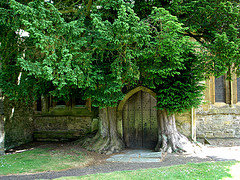
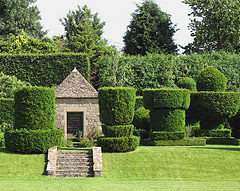
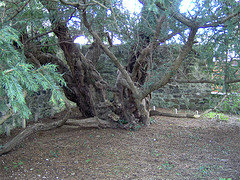
Yews flank the doors of St. Edward's Church in Stow on the Wold, England.
Yews have long been used to create topiary. The Fortingall yew, estimated to be 5,000 years old.History
Wood of the yew is springy, making it throughout history a favorite wood for bows. When Otzi, Europe’s oldest natural human mummy (dating to the Copper Age) was discovered in the Italian alps in 1991, among his possessions was an unfinished longbow made of yew wood. The bow’s owner had leaned it against a rock, where it remained upright until it was found thousands of years later.[2]
Yew is sometimes called “iron wood”, because of the fact that fence poles made of yew outlast metal ones. Some of the most ancient man-made artifacts ever found, including musical instruments, are made of yew.[1]
Traditions
The concept of the “Tree of Life”, a holy tree demonstrating the interconnectedness of all of life on earth, can be dated to the Stone Age. The philosophy spread to many different cultures, and the trees that ancient people chose to venerate varied according to their climate, but in cold northern Europe the tree most worshipped was the yew.
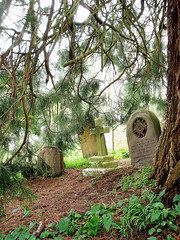 The yew has long been associated with graveyards.
The yew has long been associated with graveyards.
As "ihwaz" or "eiwaz", a rune representative of death and rebirth, the yew had its own distinct symbol in the Norse runic alphabet. An Anglo-Saxon rune poem dated to the 10th century is translated as:
“The yew is a tree with rough bark,
hard and fast in the earth, supported by its roots,
a guardian of flame and a joy upon an estate.” [3]
For Germanic peoples, the evergreen yew was associated with the winter solstice. For the Celts, it played at part at Samhain, the November 1 festival when the boundary between the dead and the living was believed to be open. This probably explains the frequent presence of yew in English graveyards, since Christian burial grounds were often built on older sacred sites. The fine for chopping down a consecrated yew in 10th century Wales was one pound, a staggering sum at the time.
The reverence with which the yew was regarded by pagans appears to have seamlessly transferred to Christianity. The long life span of the yew, coupled with the fact that its leaves remain green throughout the winter, made it a logical symbol of resurrection and eternal life. [1]
Use in Modern Medicine
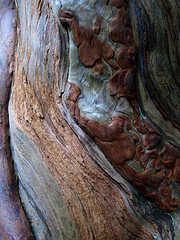 A chemical in the yew's trunk is used in a potent cancer drug.
A chemical in the yew's trunk is used in a potent cancer drug.In 1967, scientists discovered that taxol (now called paclitaxel), a substance found in the yew’s reddish bark, could be used to fight breast and lung
cancer. Until 1993, almost all the drug produced came from the Pacific yew, and over-harvesting resulted in the tree being listed as endangered. Fortunately, methods have been developed to extract paclitaxel from cultivated species of yew, sparing those in old-growth forests.[4]
Sources:
1 The Living Wisdom of Trees; Fred Hageneder; 2005
2 Otzi Museum: Otzi the Iceman
3 The Viking Rune: Names and Meanings of Runes
4 Yew Trees and Taxol
Photo credits: Yew berries, Roger B.; St. Edward's Church, 1967geezer; yew topiary, Neosnaps; yew in graveyard, silver*rose; yew bark, piX1966
Copyright © www.100flowers.win Botanic Garden All Rights Reserved